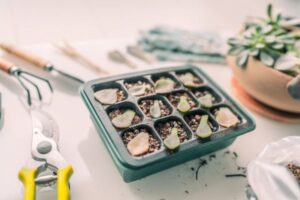In the enchanting realm of indoor gardening, where nature’s splendor converges with the comforts of home, a captivating dance of life unfolds among vibrant foliage and delicate blooms. Within this serene sanctuary, indoor plants not only bestow their beauty upon us but also contribute to improved air quality and a sense of tranquility. As nurturing gardeners, we devote ourselves to tending to the needs of our green companions, offering them the essentials of water, nutrients, and tender care. However, amidst the harmony of this natural haven, a lurking threat persists in the form of pests, those tiny, seemingly inconspicuous invaders that can wreak havoc on our beloved indoor plants.
From microscopic mites to voracious aphids, pests can infiltrate our indoor gardens, inflicting damage that may undermine months of diligent cultivation. To safeguard the flourishing health and longevity of our cherished green companions, it is essential to arm ourselves with the knowledge and strategies to prevent and combat these unwelcome guests. In this comprehensive guide, we embark on a journey that goes beyond mere pest control, exploring the delicate balance between protecting our indoor plants and preserving the delicate equilibrium of nature.
With an unwavering commitment to the principles of ecological balance, we shall delve into the identification of common indoor plant pests, understanding their life cycles and habits. As guardians of this verdant realm, we will embrace proactive measures to prevent pest infestations, cultivating a garden that thrives in harmony with the rhythms of nature. Empowered by natural and organic pest control methods, we shall approach pest management with compassion and mindfulness, ensuring the well-being of our indoor plants while preserving the broader ecological web.
So, let us don our gardening gloves and embark on this enlightening journey to prevent and deal with pests in indoor plants. Together, we shall weave a tapestry of knowledge and understanding, fusing the realms of horticulture and environmental stewardship. By the time we conclude, we will have cultivated not only a pest-resistant indoor garden but also a deep appreciation for the interconnectedness of all living beings and the wisdom to protect the fragile balance between humans, plants, and the intricate web of life.
Identifying Common Indoor Plant Pests
Within the seemingly serene confines of our indoor gardens, a hidden world of tiny intruders often lurks, posing a threat to the well-being of our beloved plants. To effectively protect our indoor garden from pest infestations, we must first familiarize ourselves with the common adversaries that may emerge. Among the most frequent culprits are aphids, those minuscule sap-sucking insects that multiply rapidly and congregate on the tender young shoots of our plants, depriving them of essential nutrients. With colors ranging from green to black and even pink, aphids can quickly weaken the plant’s structure and cause distorted growth if left unchecked.
In addition to aphids, another formidable adversary is the spider mite, a microscopic arachnid that thrives in warm and dry conditions. These eight-legged intruders often spin delicate webs on the undersides of leaves, extracting the life-sustaining sap from the plant cells. If ignored, spider mites can wreak havoc on indoor plants, leaving them with a stippled appearance and a sense of impending decline. Furthermore, the notorious mealybug poses a distinct challenge, with its cottony-white appearance and voracious appetite for plant sap. Mealybugs tend to hide in leaf axils and plant crevices, making them difficult to spot until their numbers escalate.
As dedicated gardeners, we must also be vigilant against the presence of scale insects, which present themselves as tiny, immobile bumps adhered to stems and leaves. These pests have a protective outer covering that shields them from many conventional treatments, making them formidable foes. Lastly, the elusive fungus gnat, a minuscule black fly, may seem harmless at first, but its presence can lead to severe consequences for indoor plants. Fungus gnats lay eggs in the moist soil, and the hatching larvae feed on plant roots, impairing the plant’s ability to absorb nutrients and water.
By becoming well-versed in the distinct characteristics and behaviors of these common indoor plant pests, we are better equipped to detect their presence and implement targeted treatments to protect the flourishing health of our green companions. Through vigilant observation and early intervention, we can ensure that our indoor garden remains a haven of beauty and vitality, free from the perils of unwanted intruders.
Proactive Pest Prevention Measures
An essential aspect of indoor plant care is implementing proactive pest prevention measures to minimize the risk of infestations. Prevention is often more effective and less harmful than dealing with full-blown pest problems. One of the primary strategies is to maintain a clean and hygienic indoor gardening environment. Regularly inspect your plants for signs of pests or disease, and promptly isolate and treat any affected specimens to prevent the infestation from spreading.
Introducing beneficial insects, such as ladybugs and predatory mites, into your indoor garden can serve as natural pest control. These beneficial insects prey on common indoor plant pests, acting as a form of biological control. Additionally, ensure proper ventilation and airflow around your plants to discourage pest buildup, as stagnant air can create a conducive environment for pest infestations.
Natural and Organic Pest Control Methods
When faced with pest challenges, it is essential to prioritize natural and organic pest control methods to protect both our indoor plants and the wider environment. Neem oil, derived from the neem tree, acts as a potent insect repellent and disrupts the life cycle of many pests. Dilute neem oil with water and spray it on your plants to deter and control infestations.
Another effective natural remedy is insecticidal soap, a gentle and biodegradable soap that suffocates soft-bodied insects like aphids, mites, and mealybugs. Mix the soap with water according to the manufacturer’s instructions and spray it on the affected plants. Remember to thoroughly cover both sides of the leaves, as pests often hide on the undersides.
Signs of Pest Infestations and Targeted Treatments
Vigilance is key to detecting pest infestations early and applying targeted treatments. Regularly inspect your indoor plants for any telltale signs, such as wilting leaves, yellowing foliage, sticky residue, or small bugs crawling on the plants. For each specific pest, employ appropriate treatments, such as spraying with neem oil or insecticidal soap, introducing beneficial insects, or manually removing the pests.
If the infestation is severe or persists despite your efforts, consider using natural horticultural oils like horticultural oil or dormant oil. These oils coat the pests and suffocate them, effectively controlling their population. Always follow the product instructions and avoid using harsh chemical pesticides that can harm beneficial insects and disrupt the natural balance of your indoor garden.
Creating a Pest-Resistant Indoor Environment
To establish a long-term defense against pests, creating a pest-resistant indoor environment is paramount. Start by selecting plant varieties known for their pest resistance, as some plants are naturally more resilient to common pests. Research the specific pests that are prevalent in your area and select plants that are less susceptible to their attacks.
Furthermore, practice good hygiene in your indoor garden, keeping the area clean and free of debris that might harbor pests. Regularly inspect new plants before introducing them into your indoor garden, ensuring they are free of pests and diseases. Quarantine new plants for a few weeks to monitor for any signs of infestations before integrating them with your existing plants.
Conclusion
In the quest to safeguard the well-being of our indoor plants, preventing and dealing with pests is a fundamental aspect of responsible indoor gardening. Armed with knowledge about common pests, proactive prevention measures, and natural pest control methods, we have equipped ourselves to face these tiny adversaries with determination and compassion. Through early detection and targeted treatments, we can swiftly address pest infestations and protect our green companions from harm.
Let us embrace a holistic approach, cherishing the delicate balance between our indoor garden and the natural world. By creating a pest-resistant indoor environment and prioritizing organic pest control methods, we promote the coexistence of plants and insects in harmony, recognizing the interconnectedness of all living beings. As we continue to nurture and cultivate our indoor gardens, may we remain vigilant and attentive guardians, ensuring the flourishing health and vitality of our beloved green companions for years to come. Happy gardening, where nature’s resilience and human compassion intertwine to create a thriving and pest-free indoor sanctuary.



